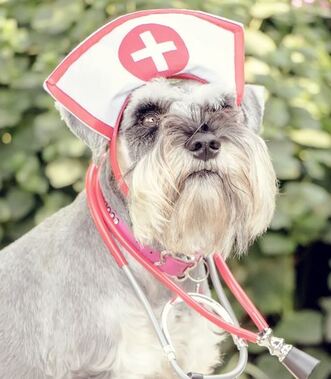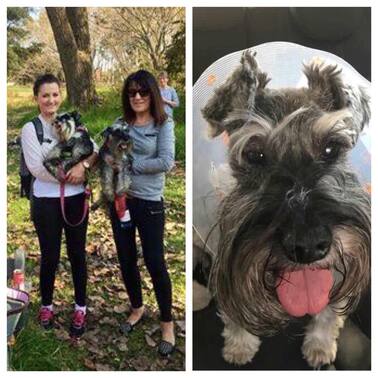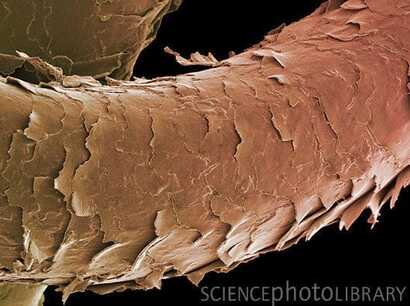Caring for your miniature schnauzer
A miniature schnauzer is a long term 12 - 18 year commitment. Your Schnauzer relies on you for his/her basic dog care needs. This includes: routine vet visits, dog grooming, dental care, daily exercise, proper nutrition, fresh water, obedience training, mental stimulation, toys, a comfy bed and spending quality time with your furry companion. By doing so, you know you’ve taken every step possible to ensure your Schnauzer's overall good health. A miniature schnauzer should weigh between 7 and 10kg’s.
 Schnauzer Schnurse Rosabella Blane is passionate about helping miniature schnauzers be healthy.
Schnauzer Schnurse Rosabella Blane is passionate about helping miniature schnauzers be healthy.
Some of the steps you might want to take to help reduce the risk of cancer/sickness in your dogs are:
Dogs Naturally Magazine is a great source of information. You can to a search on their database of articles based on a topic. Schnauzers-Rule.com also provides good information on miniature schnauzer care.
- Feed as much fresh natural unprocessed food as possible. Pellets/kibble are full of preservatives, wheat etc.
- Reduce the use of flea and tick products and find natural substitutes.
- Maintain your lawn and grounds with minimal or non-toxic herbicides, insecticides and chemicals.
- Learn more about the detergents, fabric softeners, soaps, shampoos, and cleansers that you use and begin to use products that do not contain harmful ingredients.
- Do not over vaccinate. Annual vaccinations are too many. After the puppy vaccinations, eliminate or minimize vaccinations as much as possible.
- Provide lots of love, cuddles and regular exercise.
Dogs Naturally Magazine is a great source of information. You can to a search on their database of articles based on a topic. Schnauzers-Rule.com also provides good information on miniature schnauzer care.
Common miniature schnauzer illnesses
Although considered to be a pretty healthy breed, miniature schnauzers still have a tendency towards certain dog illnesses. They are very sensitive to fat. Too much fat in their meals or a piece of boerewors slipped from the braai can make them very sick. According to Schnauzers-Rule.com, the top four health concerns for miniature schnauzers are:
Being aware of what they are and what you can start doing today to prevent them, will help you keep your Schnauzer healthy and living longer. The best way to prevent them is with a fresh healthy unprocessed (low fat) diet, regular exercise and love. Click here for more info on the above.
- Bladder Stones,
- Diabetes,
- Pancreatitis
- Schnauzer Bumps
Being aware of what they are and what you can start doing today to prevent them, will help you keep your Schnauzer healthy and living longer. The best way to prevent them is with a fresh healthy unprocessed (low fat) diet, regular exercise and love. Click here for more info on the above.
Medical aid
Medical aid is something to consider getting for your schnauzers. After my first surprise hefty vet bill for my precious schnauzer puppy Max, I signed up for pet medical aid. I chose Medipet but there are also other options to consider. It gives me peace of mind. Do your own research and read up about what is covered and what is not covered before signing up. (Your vet should have brochures).
Microchipping
Microchip your schnauzers so that they can be traced back to you! It is very important to ensure that your schnauzers are microchipped. The microchip is inserted under the skin and carries a unique code which identifies your pet. By entering the code into a computer database, your pet can be traced back to you. Regularly check that your microchip is working and that your contact details are up to date.
Ticks and flea treatment
Be aware of the risks of using tick and flea treatment and only use when necessary. We recommend natural tick and flea treatment. Every summer season, the debate rages on about the considerable dangers of topical flea and tick products. If you would like to avoid these toxins but still want to give your pet some protection, google for more natural options. The Dogs Naturally Magazine website is a good place to start.
Eye issues
Miniature Schnauzers are a breed known for certain eye problems, Here is the link to the most common schnauzer eye diseases.
Itching and licking
Diabetes
Johannesburg Schnauzer mom Janette Araujo’s schnauzer was diagnosed with diabetes and this is her story from a few years ago, but the info can possibly help any schanuzerholics with similar issues.
 Us at a Johannesburg Schnauzer Friends Fun Walk and then Kimi after her cataract surgery!
Us at a Johannesburg Schnauzer Friends Fun Walk and then Kimi after her cataract surgery!
“Hi There Deborah and Schnauzer family!
Thought I would share some information on my experience the last 8 months since Kimi was diagnosed with diabetes! I have two mini Schnauzers both turning 11 in May! Around about April last year Kimi started losing weight. Visited the vet several times as she had diarrhea on and off! Mentioned to the vet she was losing weight and was told that it was maybe a good thing as she was always a bit chubby! Towards the end of May and during June she was drinking a lot of water and needing to wee a lot! Started waking me up at least 4 times a night to go out! Filled up the water bowl during the night to! Vet changed her food to eukaneba intestinal food end of June! By this time Kimi looked emaciated and I thought she was dying!
Anyway I read up on google and realized these symptoms sounded like diabetes! Requested full blood tests and on the 7th July she was diagnosed! I started worrying about eyesight because diabetes attacks the eyes so quickly in dogs! Vet didn’t think it was a concern! I found out and started her on an eye vitamin!
Exactly one month later she started pawing at her left Eye! I rushed back to the vet where for the first time she was concerned and referred me to the Johannesburg Eye hospital! Did tests and sadly it was to late for her left eye! They are such amazing doctors there and they gave me much more information on diabetes than the vet! They were honest and told me that within two weeks she would lose her sight in her right eye! They gave me different drops to prevent uveitis and we spoke about cataract surgery! True to word two weeks later we woke up and Kimi was blind! We did not hesitate and arranged to do cataract surgery ASAP! Happy to say it was successful and was great to fetch her from the hospital and she could see! It’s not perfect but enough!
I changed vets and I am now with a really caring lady! Kimi goes for her blood glucose curves once a month and is fairly regulated! Diet is so important ! Consistent feeding 12 hours apart and of course insulin injection s after food! I make my own treats for her and she gets very few! They need a diet in high protein, low fat , high fiber minimum carbs! The Eye hospital said the acana or origin food are the best for diabetics! So Kimi eats acana with cooked chicken, pumpkin and green beans! She is doing well and is not bothered about the insulin injections!
If anyone finds out there Schnauzer has diabetes please don’t panic! Dogs can live very happily as long as they stick to there food routines! I know of people whose dogs have had diabetes from a young age! The only thing I really want to emphasize is to make sure the first thing you do is get to the Eye hospital! They need the correct drops even if you not considering surgery! I have joined the Canine diabetic facebook group and have learnt a lot there! One thing is clear that not just here but world wide many vets don’t know a hell of lot about diabetes! This is not meant to scare you as any dog as in humans can get diabetes! I really think a lot has to do with diet so feed your Schnauzers healthy meals and give them all the love they deserve! Email me at [email protected] if you want to chat re schnauzer diabetes.
Love Janette Araujo”
For more information on diabetes visit http://www.schnauzers-rule.com/diabetes.html
Thought I would share some information on my experience the last 8 months since Kimi was diagnosed with diabetes! I have two mini Schnauzers both turning 11 in May! Around about April last year Kimi started losing weight. Visited the vet several times as she had diarrhea on and off! Mentioned to the vet she was losing weight and was told that it was maybe a good thing as she was always a bit chubby! Towards the end of May and during June she was drinking a lot of water and needing to wee a lot! Started waking me up at least 4 times a night to go out! Filled up the water bowl during the night to! Vet changed her food to eukaneba intestinal food end of June! By this time Kimi looked emaciated and I thought she was dying!
Anyway I read up on google and realized these symptoms sounded like diabetes! Requested full blood tests and on the 7th July she was diagnosed! I started worrying about eyesight because diabetes attacks the eyes so quickly in dogs! Vet didn’t think it was a concern! I found out and started her on an eye vitamin!
Exactly one month later she started pawing at her left Eye! I rushed back to the vet where for the first time she was concerned and referred me to the Johannesburg Eye hospital! Did tests and sadly it was to late for her left eye! They are such amazing doctors there and they gave me much more information on diabetes than the vet! They were honest and told me that within two weeks she would lose her sight in her right eye! They gave me different drops to prevent uveitis and we spoke about cataract surgery! True to word two weeks later we woke up and Kimi was blind! We did not hesitate and arranged to do cataract surgery ASAP! Happy to say it was successful and was great to fetch her from the hospital and she could see! It’s not perfect but enough!
I changed vets and I am now with a really caring lady! Kimi goes for her blood glucose curves once a month and is fairly regulated! Diet is so important ! Consistent feeding 12 hours apart and of course insulin injection s after food! I make my own treats for her and she gets very few! They need a diet in high protein, low fat , high fiber minimum carbs! The Eye hospital said the acana or origin food are the best for diabetics! So Kimi eats acana with cooked chicken, pumpkin and green beans! She is doing well and is not bothered about the insulin injections!
If anyone finds out there Schnauzer has diabetes please don’t panic! Dogs can live very happily as long as they stick to there food routines! I know of people whose dogs have had diabetes from a young age! The only thing I really want to emphasize is to make sure the first thing you do is get to the Eye hospital! They need the correct drops even if you not considering surgery! I have joined the Canine diabetic facebook group and have learnt a lot there! One thing is clear that not just here but world wide many vets don’t know a hell of lot about diabetes! This is not meant to scare you as any dog as in humans can get diabetes! I really think a lot has to do with diet so feed your Schnauzers healthy meals and give them all the love they deserve! Email me at [email protected] if you want to chat re schnauzer diabetes.
Love Janette Araujo”
For more information on diabetes visit http://www.schnauzers-rule.com/diabetes.html
Car sickness
CAR SICKNESS TIPS by schnauzer mom Leandri Heysteck. Here are her tips for helping your schnauzer if they get car sick. The picture is her schnauzer Luka. 🐾

1. Elevation
If you want to splurge, I suggest a woof seat. As they're a bit costly I have bought a bucket, filled it with dog blankets and put it on my front seat. Whether Luka is sitting up or laying down, he can still see what's going on outside which is a great help with the motion sickness.
2. Stability
You need to ensure the elevation structure doesn't move around. I found that sitting on the seat without a structure also contributed to the motion sickness.The woof seat seems to be held in place by the seat belt. I am still looking for a solution to keep the bucket in place, but it isn't a problem unless I take a sharp turn, in which case just hold onto the bucket. As both solutions (like your baby car seat) hold them in place this is also a great help.
3. Get them to relax
I have a ruffwear harness that acts as a thunder jacket and a doggy seat belt in that it gives a nice hug which keeps him calm and - if an accident were to happen - would spread the impact more evenly on his body than a standard H-harness. In the beginning when he developed a fear for car rides I would give him dog-friendly nausea and sleeping tablets (consult your vet) when we had long rides to do and slowly weaned him off as his stress level lowered.
4. Exposure
Show them car rides aren't scary and try to build their tolerance by taking them for frequent, short trips. If I need to buy a bottle of milk I'll take him with. It's a lot of effort for what would be a quick trip, but well worth it!
5. Wind/ Cold air
Last but not least, I always have a window open or have the aircon blowing in his direction.
If you want to splurge, I suggest a woof seat. As they're a bit costly I have bought a bucket, filled it with dog blankets and put it on my front seat. Whether Luka is sitting up or laying down, he can still see what's going on outside which is a great help with the motion sickness.
2. Stability
You need to ensure the elevation structure doesn't move around. I found that sitting on the seat without a structure also contributed to the motion sickness.The woof seat seems to be held in place by the seat belt. I am still looking for a solution to keep the bucket in place, but it isn't a problem unless I take a sharp turn, in which case just hold onto the bucket. As both solutions (like your baby car seat) hold them in place this is also a great help.
3. Get them to relax
I have a ruffwear harness that acts as a thunder jacket and a doggy seat belt in that it gives a nice hug which keeps him calm and - if an accident were to happen - would spread the impact more evenly on his body than a standard H-harness. In the beginning when he developed a fear for car rides I would give him dog-friendly nausea and sleeping tablets (consult your vet) when we had long rides to do and slowly weaned him off as his stress level lowered.
4. Exposure
Show them car rides aren't scary and try to build their tolerance by taking them for frequent, short trips. If I need to buy a bottle of milk I'll take him with. It's a lot of effort for what would be a quick trip, but well worth it!
5. Wind/ Cold air
Last but not least, I always have a window open or have the aircon blowing in his direction.
Why do schnauzer beards stain brown?

Author: Francois Spangenberg from Keystone Miniature Schnauzers says "Firstly we need to understand why it can stain. The staining is MOSTLY depending of the particular dogs hair structure. Some dogs never, ever stain. No food stain. No water stain No bacterial stain. It remains almost pure white most of the time if not all the time.
Looking at the picture courtesy the world wide web we see the "scales" or "cells" packed in closely to form a strand of hair. Some hair will have wider gaps between these cells. These wider gaps allows for mineral stains from water, food and bacteria to accumulate in these crevasses. Most of the stain are actually bacterial stains due to food particles being trapped in the beards. The bacteria live on the food and saliva. No amount of washing will completely remove the problem since at a genetic level the hair is predisposed to staining. It will alleviate it to some extent but not eliminate it all together. Dedicated breeders around the world are aware of "clean beards" and we constantly breed toward this goal.
Over the years I have had many dogs with pure white beards and trimmings. No food stains, no bacterial stains and no trace elements stains from water. These "clean" coats have a different look to them compared to other coats. THEY LITERALLY LOOK LIKE THEY HAVE A SPARKLE to their coats most of the time. They also look clean most of the time compared to other coats. Really lovely to see. Sometimes all we can do is to accept the condition and do some damage control. Feeding natural good healthy food will/can help a lot. Giving a little pre-biotics for some in the water can also help crowding out some of the less desirable bacteria. Giving purified water and keeping the beard clean 24.7 can help a lot too. But then if u fail a day or two or they play in the mud it is back to square one. Moral of the story? change what you can and accept the rest.
Looking at the picture courtesy the world wide web we see the "scales" or "cells" packed in closely to form a strand of hair. Some hair will have wider gaps between these cells. These wider gaps allows for mineral stains from water, food and bacteria to accumulate in these crevasses. Most of the stain are actually bacterial stains due to food particles being trapped in the beards. The bacteria live on the food and saliva. No amount of washing will completely remove the problem since at a genetic level the hair is predisposed to staining. It will alleviate it to some extent but not eliminate it all together. Dedicated breeders around the world are aware of "clean beards" and we constantly breed toward this goal.
Over the years I have had many dogs with pure white beards and trimmings. No food stains, no bacterial stains and no trace elements stains from water. These "clean" coats have a different look to them compared to other coats. THEY LITERALLY LOOK LIKE THEY HAVE A SPARKLE to their coats most of the time. They also look clean most of the time compared to other coats. Really lovely to see. Sometimes all we can do is to accept the condition and do some damage control. Feeding natural good healthy food will/can help a lot. Giving a little pre-biotics for some in the water can also help crowding out some of the less desirable bacteria. Giving purified water and keeping the beard clean 24.7 can help a lot too. But then if u fail a day or two or they play in the mud it is back to square one. Moral of the story? change what you can and accept the rest.
Fireworks - tips to keep your schnauzers safe.
- Keep some lights on. Keeping a light on will calm your pet and make him feel more secure, rather than being scared in a dark room.
- Dampen the noise. Close the curtains in the room and, if your animal is a caged one, cover up the cage in a thick blanket, but make sure it is breathable so your animal doesn't suffocate. This will also help to stop the flashes of light affecting your pet.
- Plan to use familiar sounds to drown out the noise of the fireworks. Music from a stereo or turning on the TV are likely familiar sounds that can sooth your pet. Just make sure not to play these sounds ridiculously loud as they can become bothersome themselves.
- Prepare the room. Select a suitable room where you will contain the pets for the duration of the fireworks. An inner room that is least impacted by the noise is ideal. It should be a room that you can close off to prevent your pet from running about the house and injuring itself, wrecking furniture, etc.
- If you have more than one pet, be sure they don't mind being confined in the same room, or select several rooms for different pets. For example, dogs and cats will usually appreciate being kept separate.
- Make the room cozy. Put down familiar, clean bedding somewhere pleasant such as under a table, on or behind a chair, etc.
- Add some familiar chew toys, scratch pads, balls, etc., to keep your pets amused and distracted.
- Remove any sharp items from the room in case your pet starts jumping or running around.
- Be sure to leave sufficient water and food for your pet in the confinement space. Many pets will be uneasy, or even frantic. If your pet has access to water, it will help calm him, and food supplied in your pet's regular portion will make him feel like it's a normal day.
- Keep an eye on your pet, and if possible, stay with them. Comfort them and talk to her. Be friendly but don't fuss over them too much; this can increase their anxiety if they pick up on yours.
Useful Links
General Schnauzer Information
These places are good sources of info:
These places are good sources of info:
- Planet Paws
- Dogs Naturally Magazine
- Dr. Karen Becker (Mercola Healthy Pets)
- Schanuzers Rule
